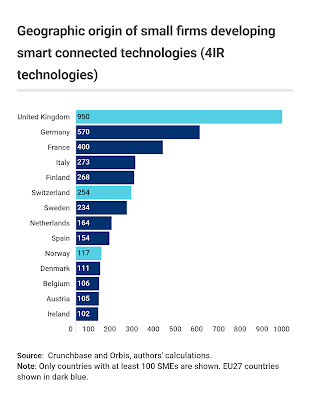Joint Report by the European Patent Office and the the European Investment Bank on Fourth Industrial Revolution Technologies
On 28 April 2022, the European Patent Office and the European Investment Office published a joint report entitled Deep tech innovation in
smart connected technologies
A comparative analysis of SMEs in Europe and the United States
April 2022. Although the report contained a lot of positive findings, the headline of the EPO's news item was decidedly gloomy: "Despite impressive patent activity, Europe’s small deep tech businesses lag behind their US counterparts."
Part of the reason for the gloom is that report focused on the EU rather than Europe as a whole. Consequently, it missed the fact that the UK has almost 1,000 small and medium-sized enterprises developing 4IR technologies (nearly twice as many as Germany with 570 and nearly two and a half times as many as France with 400) and that London hosts one of the top clusters of such businesses (see page 30 and the map on page 29 of the main report). It would have been interesting to know the reasons for the UK and London's relatively good performance such as the pre-eminence of the City of London as a financial centre or the strength of the UK's research universities. The map shows appears to show concentrations of 4IR SME around Oxford and Cambridge as well as the West Midlands, Northwest, the Bristol-Cardiff corridor and East of Scotland.
The news item includes cloud computing, the internet of things, 5G networks and artificial intelligence within the definition of 4IR technologies. Surprisingly that definition does not seem to cover life sciences even though AI and the rapid analysis of big data sets by machines are the routes for most modern medical advances.
The report is 87 pages long and is divided into a foreword, executive summary, 9 chapters and 3 annexes. The chapter headings are:
The news item includes cloud computing, the internet of things, 5G networks and artificial intelligence within the definition of 4IR technologies. Surprisingly that definition does not seem to cover life sciences even though AI and the rapid analysis of big data sets by machines are the routes for most modern medical advances.
The report is 87 pages long and is divided into a foreword, executive summary, 9 chapters and 3 annexes. The chapter headings are:
- Introduction
- 4IR Patenting and the Contribution of SMEs
- Innovation and Business Profiles of 4IR SMEs
- Market and IP Positions
- Financial Profile and Structural Barriers
- Investment Activities
- Exit
- Policy Recommendations, and
- Conclusions.
The annexes deal mainly with the authors' methodologies.
The report's key findings include:
"There are twice as many SMEs with an international
portfolio of 4IR patents in the US than in the EU27,
adding to the overall leadership of the US in advanced
digital technologies."
"A large proportion of 4IR SMEs in both the EU and US cite the availability of finance (73% and 77% respectively) and the availability of staff with the required technical skills (73% and 76% respectively) as business barriers."
Anyone wishing to discuss this article can call me on +44 (0)20 7404 5252 during office hours or send me a message through my contact form.

.jpg)
%20(1).jpg)
.jpg)
Comments
Post a Comment